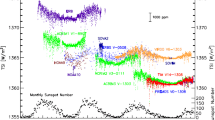Abstract
Indices of solar activity relevant for understanding and modelling solar irradiance variability are identified, and their temporal characteristics compared. Reproducing observed solar irradiance variability requires a minimum of two different types of indices — an index for irradiance depletion by sunspots and an index for global irradiance enhancement by faculae and network. When combined with appropriate wavelength-dependent parameterizations of sunspot and facular contrasts and center-to-limb functions, these indices permit the construction of empirical models of daily, monthly and annual solar total and spectral irradiances. The models are compared with observations at selected wavelengths and for the total irradiance. While the models replicate much of the rotational and 11-year cycle variance in contemporary irradiance databases, differences exist because of either the presence of variability mechanisms additional to solar magnetism, or of unresolved instrumental effects in the databases. The reconstruction of solar irradiance in the past requires speculation about the extent of intercycle fluctuations in the global facular index, or in other, as yet unspecified, variability mechanisms.
Similar content being viewed by others
References
Allen, C. W.: 1981, Astrophysical Quantities, 3rd Edition, Athlone, London.
Beer, J.: 2000, ‘Long-Term Indirect Indices of Solar Variability’ Space Sci. Rev., this volume.
de Toma, G., White, O. R., Knapp, B.G., Rottman, G. J., and Woods, T. N.: 1997, ‘Mg II core-to-wing index: Comparison of SBUV 2 and SOLSTICE time series’, J. Geophys. Res. 102, 2597.
Fligge, M., and Solanki, S. K.: 1997, ‘Inter-cycle variations of solar irradiance: Sunspot areas as a pointer’, Solar Phys. 173, 427.
Fontenla, J., White, O. R., Fox, P. A., Avrett, E. H., and Kurucz, R. L.: 1999, ‘Calculation of Solar Irradiances. I. Synthesis of the Solar Spectrum’, Astrophys. J. 518, 480.
Foukal, P.: 1998, ‘Extension of the F10.7 Index to 1905 using Mt. Wilson Ca K Spectroheliograms’, Geophys. Res. Lett. 25, 2902.
Foukal, P. and Lean, J.: 1988, ‘Magnetic Modulation of Solar Luminosity by Photospheric Activity’, Astrophys. J. 328, 347.
Fröhlich, C.: 2000, Space Sci. Rev., this volume.
Fröhlich, C. and Lean, J.: 1998, ‘The Sun's Total Irradiance: Cycles, Trends and Climate Change Uncertainties since 1976’, Geophys. Res. Lett. 25, 4377.
Harvey, K. L., and White, O. R.: 1998, ‘Spectral Irradiances and Magnetic Structures’, Astronomical Society of the Pacific Conference Series 140, 247.
Hoyt, D. V., and Schatten, K. H.: 1993, ‘A Discussion of Plausible solar irradiance variations’, J. Geophys. Res. 98, 18,895.
Hoyt, D. V., and Schatten, K. H.: 1997, ‘The Role of the Sun in Climate Change’, Oxford University Press, Oxford.
Hoyt, D. V., Schatten, K. H., and Nesme-Ribes, E.: 1994, ‘The One Hundredth Year of Rudolf Wolf's Death: Do we have the Correct Reconstruction of Solar Activity?’, Geophys. Res. Lett. 21, 2067.
Kuhn, J. R., and Libbrecht, K.: 1991, ‘Nonfacular Solar Luminosity Variations’, Astrophys. J. 381, L35.
Lean, J., and Rind, D.: 1998, ‘Climate forcing by changing solar radiation’, J. Climate 11, 3069.
Lean, J. L., Rottman, G. J., Kyle, H. L.,Woods, T. N., Hickey, J. R., and Puga, L. C.: 1997, ‘Detection and parameterization of variations in solar mid and near ultraviolet radiation (200 to 400 nm)’, J. Geophys. Res. 102, 29939.
Lean, J. L., Cook, J., Marquette, W., and Johannesson, A.: 1998, ‘Magnetic modulation of the solar irradiance cycle’, Astrophys. J. 492, 390.
Rottman, G.: 2000, Space Sci. Rev., 1991-1999’, this volume.
Sofia, S., and Fox, P.: 1994, ‘Solar Variability and Climate’, Climate Change 30, 1.
Solanki, S. K., and Unruh, Y. C.: 1998, ‘A model of the wavelength dependence of solar irradiance variations’, Astron. Astrophys. 329, 747.
Unruh, Y. C., Solanki, S. K., and Fligge, M.: 2000, ‘Modelling Solar Spectral Irradiance Variations’, Space Sci. Rev., this volume.
White, O. R., Skumanich, A., Lean, J., Livingston, W. C., and Keil, S. L.: 1992, ‘The Sun in a Non-cycling State’, Publications of the Astronomical Society of the Pacific 104, 1139.
White, O. R., Livingston, W. C., and Keil, S. L.: 1998,’ Variability of the Solar CaII K Line over the 22 Year Hale cycle’, Astronomical Society of the Pacific Conference Series 140, 293.
Willson, R. C.: 1997, ‘Total Solar Irradiance Trend During Solar Cycles 21 and 22’, Science 277, 1963.
Worden, J. R., White, O. R., and Woods, T. N.: 1998, ‘Evolution of chromospheric structures derived from CaII K spectroheliograms: implications for solar ultraviolet irradiance variability’, Astrophys. J. 496, 998.
Author information
Authors and Affiliations
Rights and permissions
About this article
Cite this article
Lean, J. Short Term, Direct Indices of Solar Variability. Space Science Reviews 94, 39–51 (2000). https://doi.org/10.1023/A:1026726029831
Issue Date:
DOI: https://doi.org/10.1023/A:1026726029831




